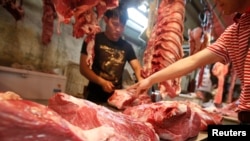Americans are not eating as much meat as they used to. Price is certainly a major reason. But people also say there are other reasons, such as health and ethics.
For the first time, a group of advisers to the United States Department of Agriculture is suggesting that Americans consider the environment when making healthy food choices. This suggestion has caused some debate.
Every five years, the United States Department of Agriculture issues Dietary Guidelines for Americans. These guidelines are based on updated nutritional science.
Janet Riley is a top official with the trade group, North American Meat Institute.
She says the department’s suggestions, or recommendations, affect some of the most vulnerable people in America: those who depend on school lunches and federal programs for older people, women and children.
"And these are some of our most vulnerable populations who need the protein and the vitamins and minerals that are in meat and poultry."
The advisory report is open for public review. Some parts of it have caused debate. The part causing the most debate is the report’s link between healthy food choices and environmental sustainability.
Janet Riley says the discussion of environmental sustainability is not part of what the House of Representatives told the committee to consider.
"They were told specifically to focus on nutrition. When they formed a subcommittee on sustainability, the House (of Representatives) appropriators included language in the budget bill that said, ‘Stick to nutrition. Do not stray into the environment'."
However, some people say that including environmental issues is good for the public and the planet. One of these people is Janet Larsen, a research director for the Earth Policy Institute, an environmental group.
Ms. Larsen says that meat production releases a lot of carbon gas into the environment.
"Meat production is very carbon intensive. It releases greenhouse gases that are warming the planet. And so, if you’re concerned about climate change, you realize that you need to start eating lower on the food chain to reduce your overall carbon footprint."
Farm animals that are raised for food require a lot of land, food and water. Ms. Larsen says. This is part of their carbon footprint.
While the United States is eating less meat, other parts of the world are eating more. China is now the world's top meat consumer. Ms. Larsen says China’s desire for meat is growing.
"If China tries to not just increase their meat imports, but increase their domestic production at a large scale, that is likely to mean that they will be importing more grain and more soy, especially from world markets. That will have an effect on food prices everywhere. We know that when food prices are volatile or if they spike, we see more and more people end up hungry."
Janet Riley, again, who represents the Meat Institute, says people who are experts in nutrition are not experts in the environment. She says the panel does not have enough scientific information or knowledge to link the environment to food guidelines.
"…to suggest that somehow eating less meat is going to have this huge impact on the environment. We need more data. We need a panel of experts in that field to take a look at it and come up with real definitive recommendations if we want to go there. We can't have nutritionists trying to delve into a field where they really don't have the expertise to make these kinds of recommendations."
The aim of the guidelines is to control disease and obesity, the condition of being overweight. The guidelines do this by suggesting a diet higher in vegetables and lower in animal-based foods. Ms. Larsen says she hopes the final version of the guidelines provides more reasons to eat healthier overall.
"I think that it is really important not to export the meat heavy American diet, but export messages of health and wellness and environmental sustainability, and show people that we realize that we have likely overshot and now we need to move down the food chain and eat less meat."
The United States Department of Agriculture will issue its final dietary guidelines later this year.
I’m Anna Matteo.
Rosanne Skirble reported this story from Washington, D.C. for VOA News. Anna Matteo wrote it for Learning English. Caty Weaver was the editor.
_______________________________________________________________
Words in This Story
recommendation – n. a suggestion about what should be done
vulnerable – adj. easily hurt or harmed physically, mentally, or emotionally
sustainability – n. involving methods that do not completely use up or destroy natural resources
stray – v. to go in a direction that is away from a group or from the place where you should be
food chain – n. a series of types of living things in which each one uses the next lower member of the series as a source of food
carbon footprint – n. the amount of carbon dioxide and other carbon compounds emitted due to the consumption of fossil fuels by a particular person, group, etc.
consumer – n. a person who buys goods and services for personal use










